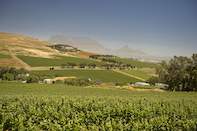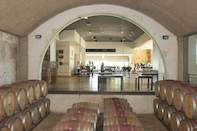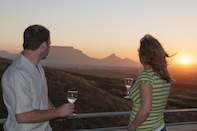A tour of Durbanville Hills an impressive hill-top winery is a must, offering insight into the hi-tech world of winemaking, with magnificent views of the Cape Peninsula to match.
Community Winemaking

A visit to the ultra-modern concrete-and-stone Durbanville Hills winery is an awe-inspiring experience. Riding high on a hill like a ship on a sea of vineyards, the cellar represents a new way of winemaking in South Africa: combining private enterprise with corporate expertise to make and sell wines in generous quantities as well as limited edition parcels.
Durbanville Hills sources all its grapes from the immediate vicinity, and in doing so is very much a community project. For years, a handful of local growers watched their top-quality grapes and wines disappear into the best-selling brands of large wine producers.
Finally, in the late 1990s, they came to an arrangement with the wine and spirits giant Distell. The company built the ultra-sophisticated cellar on land belonging to one of the participating farmers while they, now shareholders, guaranteed the winery their combined crop.
Cellar Giant

A guided tour through the cellar gives you some idea of the remarkable scale of this enterprise. From the restaurant, a passage leads to massive glass doors that open onto a mezzanine-level walkway. Here you're in the company of giants: two connecting double-height cellars house row upon row of large, stainless steel fermentation tanks.
They are extraordinary - as are the figures, fluctuating as they may over the seasons as requirements and investment dictate. At one point there have been some 250 of these tanks, their individual capacities ranging from 6 000 to 100 000 litres.
Together they hold enough wine to fill nearly two million bottles. Downstairs, the maturation cellar may be stacked with upwards of 2 000 barrels of French and American oak, each with a capacity of 300 litres.
The grapes used – around 6 000 tons each year, though the cellar is built to handle up to 8 000 tons – are handpicked from about 770 hectares of vines. Sauvignon Blanc and Merlot are specialities, appearing across the portfolio.
The top-tier, single-varietal Collectors Reserve wines, from selected vineyards or batches of exceptional quality, are named after and feature back-label, hand-coloured lino-cuts by local artist Theo Vorster depicting Cape Town landmarks, from Table Mountain’s cableway and the Castle of Good Hope to Signal Hill’s historic noon-day cannon, the Mouille Point lighthouse and rich coastal flora and fauna.
His work also adorns the winery’s new easy-drinking Cape Portrait blends. The middle-tier eponymous Durbanville Hills range includes bottlings of all the most popular varieties of wines, as well as an MCC, sparkling wines and rosé.
Tangram

Juggling the different facets of this huge operation is devoted cellarmaster Martin Moore, who has been at Durbanville Hills since the cellar was completed in time for the winery’s first harvest in 1999. He is supported by two specialist winemakers: one for white wines and the other for red, plus young assistants he mentors.
It’s teamwork that has enabled such a large winery to source, vinify and bottle small quantities of distinctive wines, most recently a flagship red blend of the five classic Bordeaux red varieties (cabernet sauvignon, merlot, cabernet franc, petit verdot, malbec) and a typically Bordeaux white blend of sauvignon blanc and semillon, both under the new Tangram label (a tangram is a Chinese geometrical seven-piece puzzle comprising five triangles, a square and a rhomboid, which can be arranged to make various forms and pictures).
Tangram is also the name of the winery’s upstairs restaurant, recognised for its signature contemporary take on South African food, served in a double-volume, airy space with décor featuring wood finishes and earthy tones.
The view of a crimson sunset over Table Bay and the lights of Cape Town in the distance make for a romantic evening dining experience, yet children are always welcomed at Durbanville Hills too.
An expert on traditional South African food, Moore specialises in matching his wines with exotic recipes for potjiekos (meat and vegetables slow cooked in a cast-iron pot over an open fire), and has been known to happily contribute to various festive open days, harvest celebrations and Durbanville region wine-and-food events.
Pairing wine with local delicacies, be it biltong (jerky), cheeses, chocolates or selected sweet treats, is part of the tasting experiences on offer. The tasting room also has a daily menu, available to be enjoyed indoors or ‘outside’ in the glass-walled Olive Grove Bistro or on lawn seating under the trees with views across the vine-clad hillsides.
Leading off the restaurant upstairs is the Bastion with a magnificent 180-degree sweep from Table Mountain across Table Bay to Robben Island and beyond. The design of this lookout point is based on the stone bastions of the 17th-century Castle of Good Hope in Cape Town, South Africa’s oldest building.
Enjoy the view, but hang on to your hat. It’s almost always breezy, with winds coming from all directions, which is what contributes to Durbanville’s cool-climate bona fides for quality wine production.
 The winelands of Constantia and Durbanville share more than just their conveniently close proximity to Cape Town. Their elegant, fruit-rich ...
The winelands of Constantia and Durbanville share more than just their conveniently close proximity to Cape Town. Their elegant, fruit-rich ...